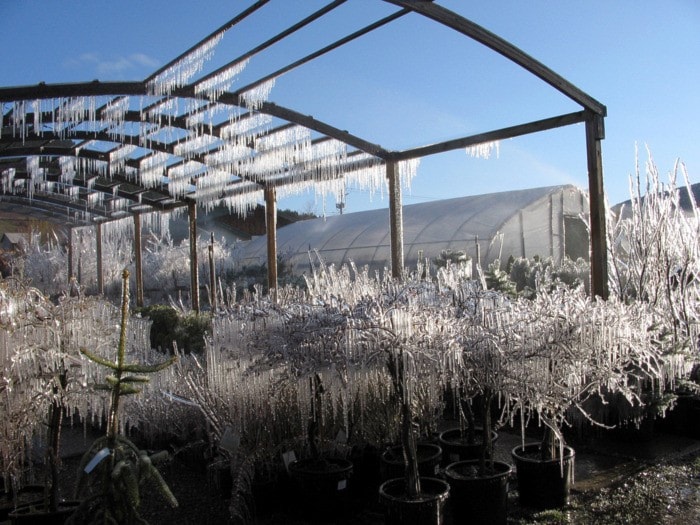Would it matter if spring came early for you? I believe that most people would rather enjoy it! Customers are already inquiring after products in the nursery, which is nice. It is a good sign for the garden centre.
However, for your local orchardists and anyone growing fruit in their gardens, an early spring can have severe consequences. As fruit trees and berry bushes go dormant, they acquire a certain cold hardiness. As they are exposed to more cold temperatures, they become even more cold-hardy until they reach their full potential. I believe the magic number for cherry trees is near -30 C.
In any case, when exposed to mild winter temperatures they progressively loose their cold hardiness, in some cases faster than it was induced. Warmer weather thaws the ground and causes the plants to push up sap. Fruit buds swell. The danger to the plant lies in these late cold snaps or hard spring frosts. In small fruit and fruit trees, the fruit buds can be damaged by temperatures even a few degrees below zero Celsius when the flowers start to open. The damage can occur in as little time as 30 minutes. It actually takes colder temperatures to damage the buds when they are tighter, but this does occasionally occur. What happens is that the cold causes the pollen tube inside the flower to “burn”. It changes from a healthy light green colour to an unhealthy brown or black colour. Most of the damaged flowers will then fall off in a few weeks.
It is reported that you need over 50 per cent of a cherry tree’s flower buds to achieve pollination for a good crop. For other fruit trees, like apples, peaches and pears, only 10-15 per cent of the flowers must be pollinated for a good fruit set.
Good fruit growing land needs to be free of late spring frosts. Cold air flows off the mountains at night and travels much as water would to the low-lying land. Areas prone to these late spring frosts are referred to as frost pockets. Drivers need to be aware of these areas, as we all know that bridge decks over creeks and rivers tend to ice up even after roads are free and clear of any ice.
There isn’t a lot you can do to prevent frost damage. Grow varieties that leaf out later in the spring where possible and avoid planting in frost pockets. Overhead irrigation in the early morning hours can help keep frost out of your garden and off your fruit blossoms. In the nursery, we run the sprinklers for a few hours just before dawn to when the sun has come up and puts some heat into the plants.
It works like this: As the water freezes, it releases heat into the contacting plant parts (leaf or flower). As long as more water is applied, the heat keeps the plant protected to about -3 C. You may have seen pictures on the news of some citrus plantation in Florida with icicles hanging off the trees. They had to do “frost protection” to save their crop. You can do the same in your garden if need be.
Alternative frost protection to overhead irrigation are the wind machines you see at some farms in Erickson. These giant air moving machines stir up air currents, often giving the same two or three degrees of frost protection. If you were out in the country, you could even light up some dry hay in the early hours of the morning.
Therefore, I hope winter lasts for a while longer. We’ll see you in spring!
Evan Davies owns Beltane Nursery at 2915 Highway 3 in Erickson.
